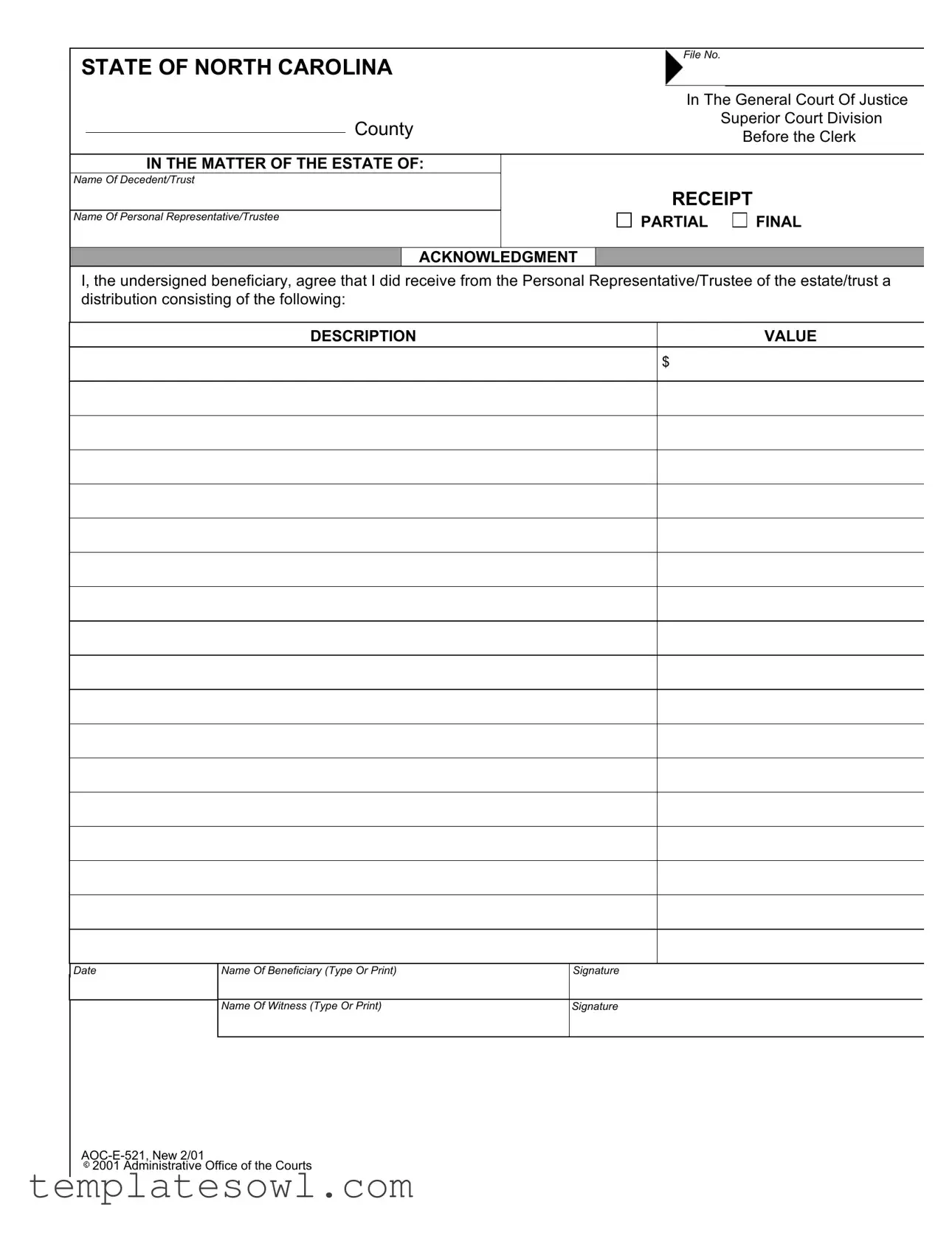What is the AOC E 521 form?
The AOC E 521 form is a legal document used in the state of North Carolina within the Superior Court Division. It serves as a receipt and acknowledgment for beneficiaries of an estate or trust, confirming the distribution they have received from the Personal Representative or Trustee. This form is crucial for maintaining clear records and ensuring a transparent process in estate management.
Who should use the AOC E 521 form?
This form is utilized by beneficiaries who have received a distribution from the estate or trust of a decedent. If you are a beneficiary and have received assets—whether cash, property, or other items—you should complete and sign this form to acknowledge receipt formally. The Personal Representative or Trustee also has a role in providing this documentation.
What information is required on the AOC E 521 form?
The form requires specific information to properly identify both the beneficiary and the estate or trust involved. Key details include the name of the decedent or trust, the name of the Personal Representative or Trustee, a description of the distribution received, its value, and the date of distribution. Additionally, both the beneficiary and a witness must sign the document to validate it.
Why is it important to complete the AOC E 521 form?
Completing the AOC E 521 form serves several important purposes. First, it provides legal protection for both the beneficiary and the estate, showing that the beneficiary has received their entitled portion. Second, it contributes to the proper accounting of estate assets, which is essential for the administration process. Lastly, having a signed acknowledgment helps prevent future disputes regarding the distribution of assets.
Is there a deadline for submitting the AOC E 521 form?
While there is no set deadline for submitting the AOC E 521 form, it is advisable to complete it as soon as you receive your distribution. This will help ensure that records are updated promptly and any potential misunderstandings regarding distributions are minimized. Always check with your estate administrator or legal advisor for guidance tailored to your specific situation.
Can the AOC E 521 form be modified?
Generally, the AOC E 521 form should not be modified, as it is a standardized form provided by the Administrative Office of the Courts. Making changes might invalidate the document or create confusion about the nature of the acknowledgment. If you believe modifications are necessary, consult with a legal professional to explore your options.
What happens if a beneficiary refuses to sign the AOC E 521 form?
If a beneficiary refuses to sign the AOC E 521 form, it can pose challenges for the Personal Representative or Trustee in documenting distributions. Without the acknowledgment, there may be uncertainty about whether the distribution was made. It is often advisable to address any concerns the beneficiary has directly and explore the reasons behind their refusal. Seeking legal counsel may also be beneficial in such cases.
How can I obtain an AOC E 521 form?
The AOC E 521 form can be obtained from the North Carolina Administrative Office of the Courts website or directly from the Clerk of Court's office in your county. It is available as a downloadable file, making it easy to access and print. If you face any challenges in locating the form, the Clerk’s office can assist you in acquiring it.
What should I do with the AOC E 521 form after it is completed?
Once the AOC E 521 form is completed and signed by both the beneficiary and a witness, it should be retained for your records. It is also recommended that a copy be provided to the Personal Representative or Trustee. This ensures all parties have proper documentation of the distribution. In addition, keeping a copy may help in case future questions arise regarding the estate's administration.



 PARTIAL
PARTIAL  FINAL
FINAL 2001 Administrative Office of the Courts
2001 Administrative Office of the Courts